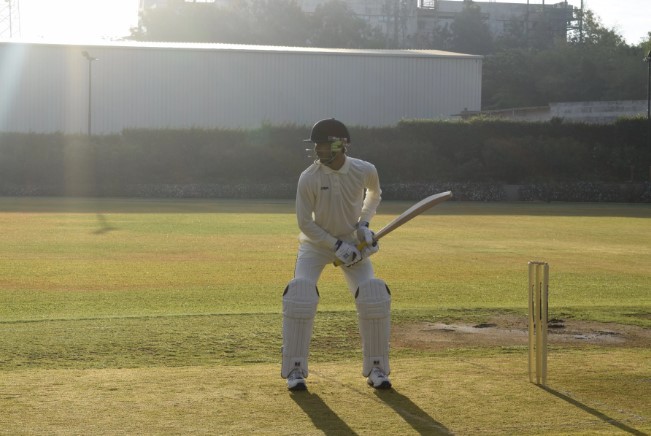In cricket, the stance is the foundation of a player’s batting technique. It’s the starting position from which every shot is played, and it plays a crucial role in both a batsman’s ability to control the ball and their overall performance at the crease. Whether it’s facing a fast bowler or a spin, a solid stance allows the batsman to be balanced, react swiftly, and execute shots with precision.
In this article, we’ll explore the different types of cricket stances, why they are important, and how they impact a batsman’s ability to play different shots.
1. What Is a Cricket Stance?
A cricket stance is the position a batsman adopts before facing a delivery. It involves the positioning of the feet, legs, body, and arms. The stance must be both comfortable and balanced, allowing the batsman to respond effectively to the bowler’s delivery. A good stance is crucial for maintaining control over the bat, staying balanced while playing shots, and adjusting to different types of deliveries, from fast balls to slower ones or spins.
A well-formed stance gives a batsman the foundation for every shot, from the defensive push to the aggressive drive. It also contributes to the batsman’s mental readiness, preparing them to anticipate and react to the ball.
2. Key Elements of a Good Cricket Stance
a. Feet Positioning
A batsman’s feet should be shoulder-width apart, providing a solid base of support. The weight should be evenly distributed across both legs, with the knees slightly bent for flexibility and movement. For a right-handed batsman, the front foot (left foot) should point towards the bowler, while the back foot should be positioned behind the front foot, ready to adjust for different types of deliveries.
When facing fast bowling, the batsman may place their back foot slightly back to give themselves more room to react. Against spin, the stance may be slightly more upright to allow better maneuverability for driving the ball.
b. Body Alignment
The body should be aligned toward the bowler, with the shoulders relaxed and not too tense. The head should be level and positioned in line with the stumps, allowing the batsman to watch the ball closely. Good posture is crucial, as it helps the batsman to judge the length and line of the ball with precision.
The upper body should lean slightly forward, as this gives the batsman better balance and stability, especially when they play forward strokes. Keeping the weight on the balls of the feet, rather than the heels, ensures quick movement in either direction, whether it’s forward or backward.
c. Hands and Bat Position
The position of the bat in the stance is vital for timing and shot execution. Typically, the bat is held in both hands with the top hand (the left hand for right-handed batsmen) positioned close to the top of the handle, and the bottom hand a bit lower. The bat should be angled slightly downwards in the stance to be ready to play both defensive and attacking shots.
The wrists should be relaxed but engaged, as this helps to maneuver the bat easily when playing shots. In some cases, players may choose a more open or closed stance based on their comfort and playing style, but the hands must always be ready to react to the ball.
d. Head and Eyes
The head is the most important part of a batsman’s stance, as it determines the ability to judge the ball. A batsman should always have their head slightly tilted forward with their eyes level. This position helps them to pick up the line, length, and swing of the ball early, allowing them to react instinctively.
A key tip for many players is to focus on the bowler’s hand to judge the ball’s trajectory more effectively. Eyes must be kept on the ball at all times, especially as it approaches. This allows the batsman to align their body and shot accordingly.
3. Types of Cricket Stances
a. Open Stance
In an open stance, the batsman positions their body slightly to the leg side, with their front foot pointing away from the bowler. This stance is commonly used when facing fast bowlers or deliveries that are expected to swing. It allows the batsman to get their bat into line quickly while giving them a better view of the bowler’s hand.
The open stance can also be used against spinners to create more room to maneuver the bat. However, it does require good footwork to ensure the batsman can still access all areas of the pitch.
b. Closed Stance
The closed stance is when a batsman has their front foot slightly angled towards the off-side, closing off the body a little. This stance is often used by batsmen who favor playing on the off-side or have a more compact playing style. It helps in covering the off-stump and provides better control for driving the ball through the off-side.
This stance is typically used for players who like to defend, as it allows them to keep the bat more aligned with the ball and gives more protection to the stumps. However, it can be limiting for playing square of the wicket and requires quick reflexes.
c. Neutral Stance
A neutral stance is the most commonly used stance in cricket. The batsman faces the bowler directly, with the feet shoulder-width apart and the body balanced. The bat is held just above the ground, slightly angled. This stance provides flexibility and allows the batsman to react to a wide range of deliveries, from quick bouncers to slower balls and spinners.
The neutral stance is ideal for players who need to play both defensive and attacking shots, as it allows easy adjustment of footwork. It is also the default stance for most top-level batsmen.
4. How the Stance Affects Different Shots
a. Front Foot Shots
A good stance allows a batsman to move confidently onto the front foot, playing shots like the cover drive, straight drive, and on-drive. The ability to get close to the pitch of the ball is essential for playing these shots, and a strong, balanced stance helps with this.
The forward motion requires good head positioning, weight transfer, and the ability to keep the bat close to the body.
b. Back Foot Shots
For back foot shots, such as the pull, cut, and square drive, the batsman needs to move quickly to the back foot to meet the ball on the rise. A proper stance helps ensure the batsman can get into position quickly and play these shots with control. The back foot positioning also helps with balance and reaction time when playing shots to shorter balls or rising deliveries.
c. Defensive Shots
A solid stance is critical when playing defensive shots like the forward defense or a block. In this situation, a batsman needs to focus on controlling the ball, especially when facing good-length deliveries. A strong base, with the bat held in front of the pad, allows the batsman to direct the ball defensively, ensuring it doesn’t lob up in the air or result in an edge.
5. Common Mistakes in Stance
- Too Much Tension: Holding the bat or body too rigidly can restrict movement. Relaxation in the hands and body is essential for quick adjustments.
- Poor Head Position: Not keeping the head level or not watching the ball closely can result in poor judgment and missed shots.
- Unbalanced Feet: If the weight is too far forward or backward, it can result in poor balance, making it hard to play both defensive and attacking shots.
The stance is the cornerstone of a batsman’s performance. A correct stance enables better footwork, shot execution, and overall control of the game. Whether it’s an open, closed, or neutral stance, each batsman may have their own preference based on their playing style, but the key is comfort, balance, and readiness to react. Mastering the stance is crucial for anyone looking to elevate their batting technique and achieve success on the cricket field.
Also Read: How Many Countries Play Cricket? A Global Overview of the Game’s Reach













